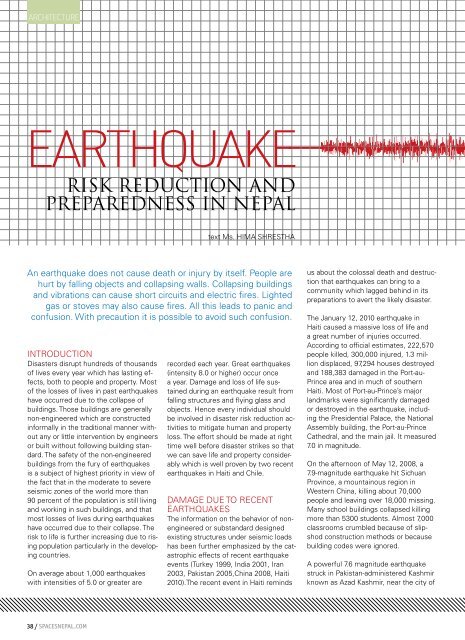7. July 2014
Create successful ePaper yourself
Turn your PDF publications into a flip-book with our unique Google optimized e-Paper software.
Architecture<br />
Earthquake<br />
Risk Reduction and<br />
Preparedness in Nepal<br />
text Ms. Hima Shrestha<br />
An earthquake does not cause death or injury by itself. People are<br />
hurt by falling objects and collapsing walls. Collapsing buildings<br />
and vibrations can cause short circuits and electric fires. Lighted<br />
gas or stoves may also cause fires. All this leads to panic and<br />
confusion. With precaution it is possible to avoid such confusion.<br />
Introduction<br />
Disasters disrupt hundreds of thousands<br />
of lives every year which has lasting effects,<br />
both to people and property. Most<br />
of the losses of lives in past earthquakes<br />
have occurred due to the collapse of<br />
buildings. Those buildings are generally<br />
non-engineered which are constructed<br />
informally in the traditional manner without<br />
any or little intervention by engineers<br />
or built without following building standard.<br />
The safety of the non-engineered<br />
buildings from the fury of earthquakes<br />
is a subject of highest priority in view of<br />
the fact that in the moderate to severe<br />
seismic zones of the world more than<br />
90 percent of the population is still living<br />
and working in such buildings, and that<br />
most losses of lives during earthquakes<br />
have occurred due to their collapse. The<br />
risk to life is further increasing due to rising<br />
population particularly in the developing<br />
countries.<br />
On average about 1,000 earthquakes<br />
with intensities of 5.0 or greater are<br />
recorded each year. Great earthquakes<br />
(intensity 8.0 or higher) occur once<br />
a year. Damage and loss of life sustained<br />
during an earthquake result from<br />
falling structures and flying glass and<br />
objects. Hence every individual should<br />
be involved in disaster risk reduction activities<br />
to mitigate human and property<br />
loss. The effort should be made at right<br />
time well before disaster strikes so that<br />
we can save life and property considerably<br />
which is well proven by two recent<br />
earthquakes in Haiti and Chile.<br />
Damage due to Recent<br />
Earthquakes<br />
The information on the behavior of nonengineered<br />
or substandard designed<br />
existing structures under seismic loads<br />
has been further emphasized by the catastrophic<br />
effects of recent earthquake<br />
events (Turkey 1999, India 2001, Iran<br />
2003, Pakistan 2005,China 2008, Haiti<br />
2010).The recent event in Haiti reminds<br />
us about the colossal death and destruction<br />
that earthquakes can bring to a<br />
community which lagged behind in its<br />
preparations to avert the likely disaster.<br />
The January 12, 2010 earthquake in<br />
Haiti caused a massive loss of life and<br />
a great number of injuries occurred.<br />
According to official estimates, 222,570<br />
people killed, 300,000 injured, 1.3 million<br />
displaced, 97,294 houses destroyed<br />
and 188,383 damaged in the Port-au-<br />
Prince area and in much of southern<br />
Haiti. Most of Port-au-Prince’s major<br />
landmarks were significantly damaged<br />
or destroyed in the earthquake, including<br />
the Presidential Palace, the National<br />
Assembly building, the Port-au-Prince<br />
Cathedral, and the main jail. It measured<br />
<strong>7.</strong>0 in magnitude.<br />
On the afternoon of May 12, 2008, a<br />
<strong>7.</strong>9-magnitude earthquake hit Sichuan<br />
Province, a mountainous region in<br />
Western China, killing about 70,000<br />
people and leaving over 18,000 missing.<br />
Many school buildings collapsed killing<br />
more than 5300 students. Almost 7,000<br />
classrooms crumbled because of slipshod<br />
construction methods or because<br />
building codes were ignored.<br />
A powerful <strong>7.</strong>6 magnitude earthquake<br />
struck in Pakistan-administered Kashmir<br />
known as Azad Kashmir, near the city of<br />
38 / SPACESNEPAL.COM


















